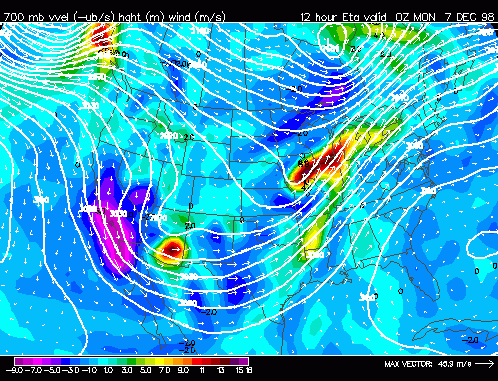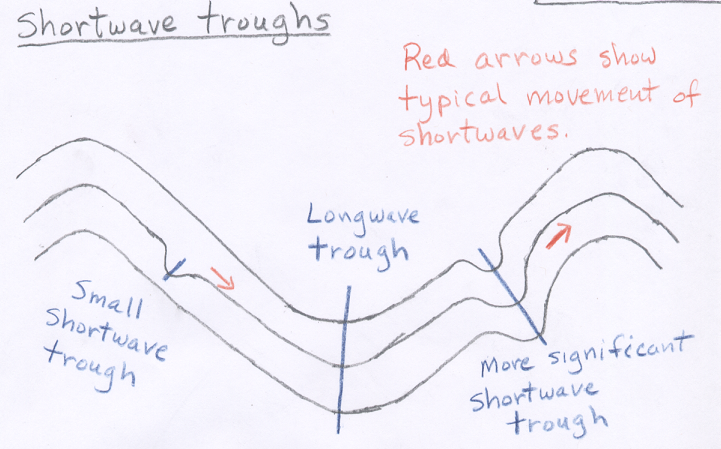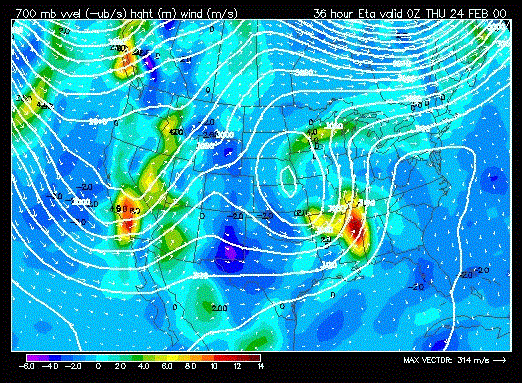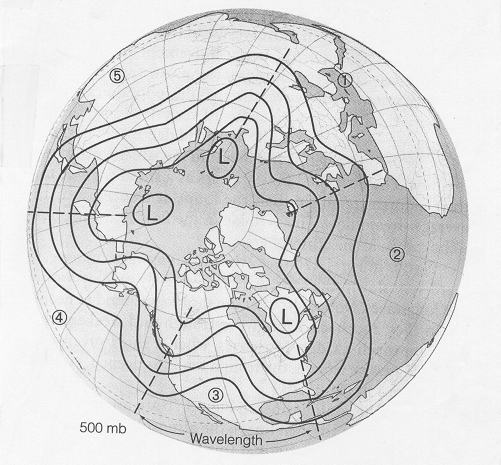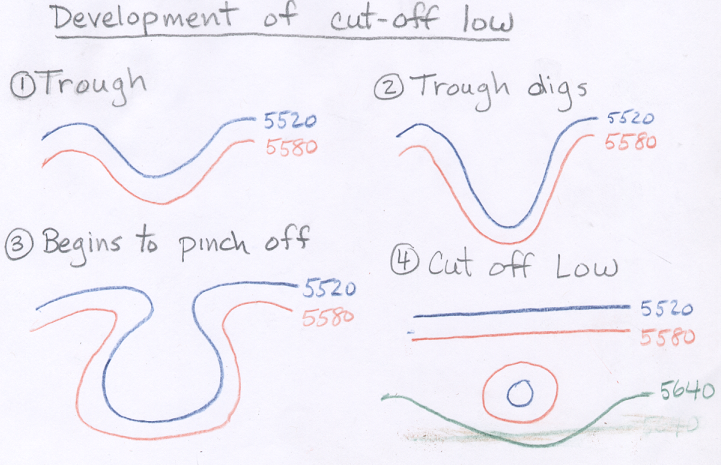Vorticity Basics
theweatherprediction.com
Synoptic scale vorticity is analyzed and plotted on the 500-mb chart. Vorticity is a clockwise or counterclockwise spin in the troposphere. 500-mb vorticity is also termed vertical vorticity (the spin is in relation to a vertical axis). This vorticity is caused by troughs and ridges and other embedded waves or height centers (speed and directional wind changes in relation to a vertical axis). A wind flow through a vorticity gradient will produce regions of PVA (Positive Vorticity Advection) and NVA (Negative Vorticity Advection). PVA contributes to rising air.
Vorticity caused by a change in wind direction or wind speed with height is termed horizontal vorticity (the spin is in relation to a horizontal axis). Horizontal vorticity is most important in the PBL (low-levels of atmosphere). i.e. If the wind at the surface is southeast at 30 knots and the wind speed at 700 mb is west at 60 knots, there will be a large amount of speed and directional (veering) shear with height and therefore a large amount of horizontal vorticity.
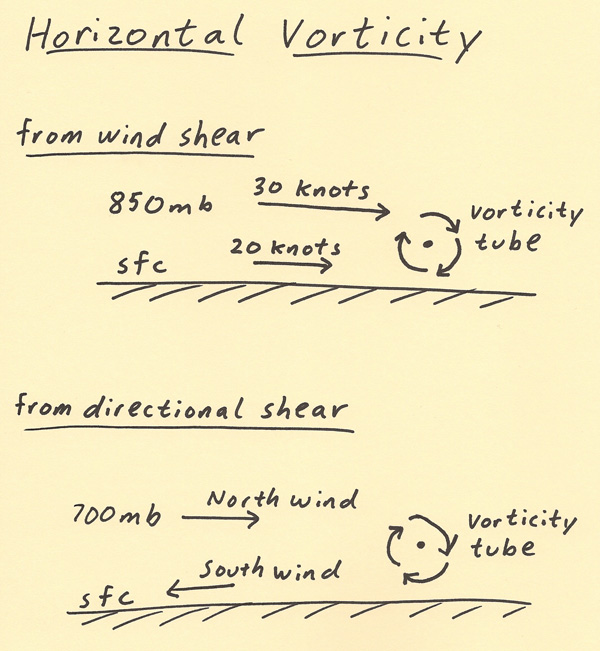
Streamwise vorticity is the amount of horizontal vorticity that is parallel to storm inflow. Storm inflow is the velocity of the low- evel wind moving toward a thunderstorm. Helicity is the amount of streamwise vorticity that is available to be ingested by a thunderstorm. Helicity is a great chart to use to assess horizontal vorticity and the threat for rotating thunderstorms.
In summary, vertical positive vorticity contributes to upper level divergence in the PVA region and thus rising air while horizontal vorticity is important to severe weather (large values of horizontal vorticity lead to large values of Helicity, which increases the likelihood of tornadoes in association with supercell thunderstorms). Both vorticity types are a clockwise or counterclockwise rotation, but one is in relation to a vertical axis and the other a horizontal axis.
For operational purposes, vorticity can be thought of simply as a COUNTER-CLOCKWISE or CLOCKWISE spin. You already know that low pressure is associated with rising air and high pressure with sinking air. Similarly, a counterclockwise spin produces POSITIVE VORTICITY while a clockwise spin in the Northern Hemisphere produces NEGATIVE VORTICITY. The three elements that produce vorticity are SHEAR, CURVATURE, and CORIOLIS. Let's define each of these terms as they apply to 500 mb vorticity.
SHEAR- A change in wind speed over some horizontal distance. Determined at 500 millibars by examining the spacing (and rate of spacing change) of height contours.
CURVATURE- A change in wind direction over some horizontal distance. This change will result in either a counter-clockwise or clockwise curvature.
CORIOLIS (aka EARTH)- It is the spinning motion created by the Earth's rotation. If you stood on the North Pole, your body would make a complete rotation in 24 hours. If you stood on the equator, your body would not spin (but rather would face straight ahead as the earth turns). Therefore, coriolis is a maximum and increases toward the poles and is a minimum and decreases toward the equator. Coriolis vorticity (also called earth vorticity) is zero at the equator, increases when wind flow is toward the pole and decreases when wind flow is toward the equator.

Absolute vorticity = shear + curvature + f (coriolis)
The magnitude and sign of each of these three terms determines the amount of absolute vorticity
POSITIVE / INCREASING VORTICITY
*Wind speed increasing when moving away from center point of trough. (positive shear vorticity)
*A counterclockwise curvature in the wind flow. This occurs in troughs and shortwaves. (positive curvature vorticity)
*A south to north movement of air. Coriolis increases (becomes more positive) when moving from the equator toward the poles.
(increasingly positive earth vorticity)
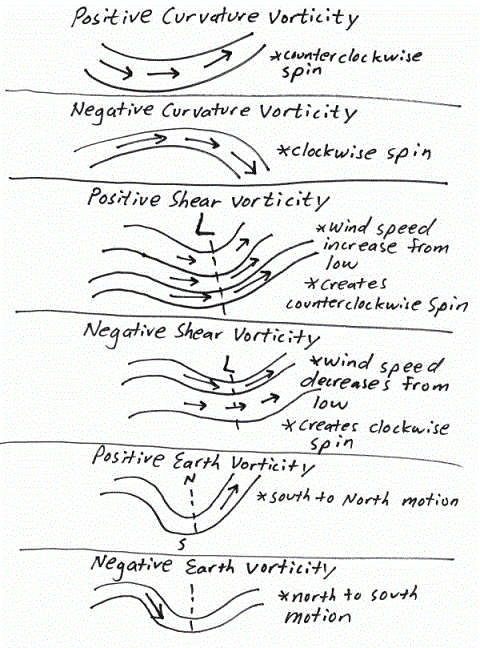
NEGATIVE / DECREASING VORTICITY
*Wind speed decreasing when moving away from center point of trough. (negative shear vorticity)
*A clockwise curvature in the wind flow. This occurs in ridges. (negative curvature vorticity)
*A north to south movement of air. Coriolis decreases (becomes less positive) when moving from the pole to the equator.
(decreasingly positive earth vorticity)
There are 6 processes that can create vorticity, four are positive (earth vorticity is always positive in magnitude (except zero at the equator) but can increase or decrease depending on if the air flow is toward or away from the equator) and two are negative. It reasons that the more terms that are positive, the higher the value of absolute vorticity will be. The highest values of vorticity are found often just to the south or east of a highly amplified trough. To the right of the trough, winds will be from a southerly direction. This makes the coriolis term increasingly positive. Winds are generally light near the center of a trough with increasing winds away from the base of the trough. This makes the shear term positive. If the trough is highly amplified, this will give a positive curvature vorticity term. To clarify things further, lets look at a paper and pen representation of the 6 contributions to vorticity and these 6 contributions on a 500 mb chart. The term "negative earth vorticity" can be described as positive earth vorticity decreasing with time. The term "positive earth vorticity" can be described as positive earth vorticity increasing with time. Earth vorticity is always positive (with the only exception of being zero at the equator); earth vorticity ranges from zero at the equator to a value equal to the earth's angular momentum at the pole.
The image that follows shows the likely position of vorticity maximums. Again, vorticity maximums will be located in areas where the most vorticity terms are positive and largely positive in magnitude. When looking at a vorticity plot or a 500 millibar chart you should now know the processes in the atmosphere that are causing the vorticity (shear, curvature, coriolis vorticity (aka earth vorticity).
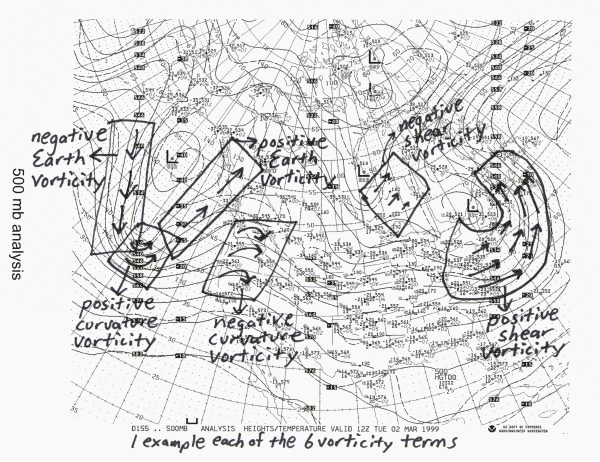
The strength of the wind is also very important. All else being equal, stronger winds will produce stronger vorticity in the base of a trough.
RELATION BETWEEN VORTICITY, DIVERGENCE AND VERTICAL MOTION
The first term of the vorticity equation states that the change in vorticity of an air parcel (following the motion) is proportional to minus the divergence. On the synoptic scale this term is far the most important effect. From the discussion of divergence, it follows that a fluid parcel which horizontally converges, stretches vertically. From the vorticity equation it follows, that the rotation of the parcel changes too and becomes more cyclonic. Conversely, a parcel that horizontally diverges, not only shrinks, but gets more anticyclonic vorticity. This is illustrated in the figure below.

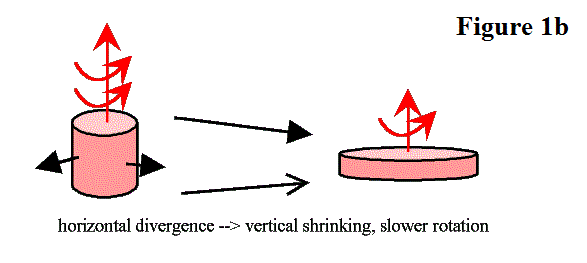
In Figure 1a the effect of horizontal convergence is shown. The parcel stretches and the vorticity becomes more cyclonic. In Figure 1b the opposite effect, horizontal divergence, is shown and the negative vorticity increases.
The relation between change in vorticity and divergence is very important, because in the moving air, parcels are deformed continuously, undergoing (horizontal) divergence or convergence. The vorticity and its changes are used to calculate divergence and, through continuity, the vertical motions, which are most important for the weather.
High vorticity is an indication of ageostrophic flow and upper level divergence. That is to say that middle level ascending motion has (horizontal) convergence below it and divergence above it, while descending motion in middle levels has divergence below it and convergence above it (see image below).
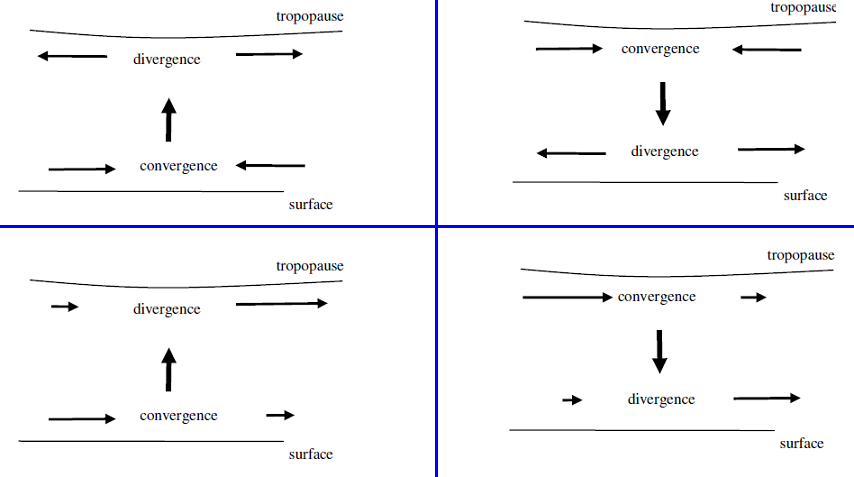
If we assume, as is usually done, that the level of nondivergence is close to the 500 mb surface, then the vorticity advection determines the motion of the associated trough or ridge. But this doesn’t tell us anything about the sign of the vertical motion. Therefore, positive vorticity advection can be associated just as well with upward as downward vertical motion. It is only when we assume that the troughs and ridges have very little slope (i.e., the vorticity gradient doesn’t change sign with height) and that the wind component perpendicular to the vorticity lines increases with height that we can use positive vorticity advection at 500 mb as an indicator of upward vertical motion.
WHAT TO LOOK FOR:
The 500 millibars chart is the best for examining the overall trough/ ridge pattern. Underneath troughs, temperatures are cooler than normal while under ridges warmer than normal.
(1) This is the best chart to assess the magnitude of vorticity. Vorticity can be generated in three different ways. They
are:
a. Curvature vorticity
b. Shear vorticity
c. Earth vorticity (Coriolis)
(2) This is the best chart in assessing the trough/ ridge pattern . A trough is an indication of cooler weather and possible precipitation while a ridge is an indication of warmer weather and fair conditions. Greatest storminess is found to right of 500 mb trough axis. a. Zonal flow - air flow is generally west to east b. Meridional flow - highly amplified troughs and ridges
(3) Use height falls and height rises to predict movement of troughs and ridges. Lows tend to develop toward regions with the greatest height falls while large height rises indicates a ridge is building into the area.
(4) Temperatures at 500 mb are rarely above 0° Celsius. Temperatures can be above 0 ° Celsius at 500 mb in a hurricane due to the warm core nature of the storm.
(5) Look for shortwaves within the longwave flow. The atmosphere will be unstable in association with shortwaves (baroclinic instability, ageostrophic flow). Precipitation is most likely to right of shortwave axis. The 500 and 700 mb charts are the best to use when locating shortwaves.
Another very good tutorial on vorticity by John Nielson-Gammon, Texas A&M University: http://atmo.tamu.edu/class/atmo251/book14vorticity.pdf





